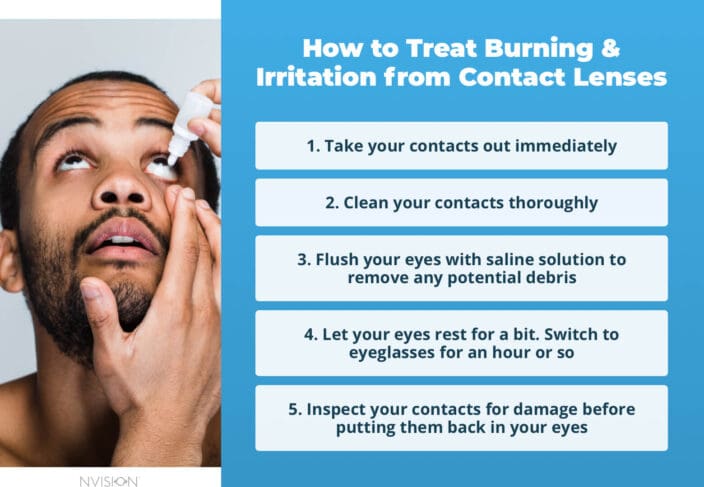How to Overcome Contact Problems: Burning Eyes & Irritation
Home / Understanding Contacts /
Last Updated:
Eye irritation from contacts can result from various causes such as germ contamination, allergies, or poorly-sized lenses. Immediate actions, proper hygiene, and both surgical and nonsurgical alternatives are explored to assist those consistently facing discomfort. Consulting an optometrist and considering personalized solutions are emphasized to ensure optimal eye health.
There are many reasons why putting your contacts in can make your eyes feel like they are burning or otherwise irritated. If you experience this sensation, remove and clean your contacts immediately, and call your optometrist if the problem persists.
If your contacts continue to bother you, consider LASIK or similar surgical procedures to negate the need for corrective eyewear. Otherwise, you can get temporary lenses that can help you see better, while sparing your eyes.

Causes for Contact Problems
If your eyes have ever experienced a burning or irritated sensation while wearing your contacts, this is not a normal occurrence, and you should address the situation as soon as possible.
There are a number of reasons why you might experience discomfort when wearing contact lenses. Here are some of them:
You deserve clear vision. We can help.
With 135+ locations and over 2.5 million procedures performed, our board-certified eye surgeons deliver results you can trust.
Your journey to better vision starts here.
Germ Contamination

One reason for the discomfort is that your contacts could be contaminated with germs or other agents on your fingers. To protect against this, wash your hands with soap and hot water for 20 seconds, and dry them with a clean towel before you touch your contacts.
This will reduce the risk of particles coming into contact with your lenses. Don’t use any hand lotion or moisturizer until after you have put your contacts in. Similarly, perfumes and other cosmetics can remain on contact lenses, so make sure you clean your face before touching your contacts.
Allergies
Allergies can also be the reason that you experience burning eyes and irritation. An allergic reaction is the result of your body interpreting an otherwise harmless substance to be, in fact, harmful. The body then uses a number of different techniques to try and expel the “intruder.”
In the same way that people with a pollen allergy sneeze a lot to get rid of the pollen particles in their nose, the eyes becoming red and irritated because of anything from dust, pollen, pet fur, perfumes, and cleaning products is also the result of the body reacting negatively to the presence of those particles on contact lenses.
If allergies are the reason your eyes feel irritated and burning, try to control the environment as best as you can (for example, clean your living space regularly). You might be able to use some over-the-counter medication to help you manage your symptoms. Ultimately, you might have to temporarily switch to eyeglasses, so your eyes do not come into direct contact with the allergens.
Tainted Cleaning Solution
Sometimes, the contact lens solution itself is the reason your eyes are suffering, even as the contact lenses themselves are not the problem. You can continue to wear your contacts, but you will need a new way of cleaning them.
With the passage of time, various combinations of germs, allergens, dust, or dirt can reduce the amount of oxygen that gets through to your eyes. This can cause the characteristic irritation and burning you feel when you put your contacts in. Your optometrist can recommend alternative cleaning solutions.
Dry Eyes
Dry eyes can also be a reason it hurts when your contacts are in. If you notice redness, scratchiness when you blink or move your eyes, the feeling that something is stuck in your eye even though it looks like nothing is, or your eyes watering too much, you may have dry eyes.
It is very easy to test for dry eyes, and there are a number of treatments that can help you moisturize your eyes. This will also reduce the discomfort you have putting your contacts in.
Wearing Lenses for Too Long
Contact lenses are only meant to be worn for limited periods of time, but as many as 60 percent of people say they wear their contacts for longer than recommended. It is a bad habit, and one that can damage the eyes — both short term and permanently — by depriving the eyes of their necessary contact with oxygen or exposing the eyes to bacterial particles on the surfaces of the lenses.
Always make sure that you give your eyes a break from your contacts at prescribed intervals.
Poorly-Sized Lenses
Ill-fitting contacts can also account for burning and irritation in the eyes. It is very important that your contacts are perfectly fit to your eyes. This ensures they can appropriately help with your vision and that they are comfortable and safe to wear.
Contacts need the precise amount of curvature, thickness, and diameter needed for your eyes and vision needs. A burning sensation when putting your contacts in might mean they were not sized properly or that your eyes are no longer the same dimensions they were when you were originally fitted for your contacts.
You can talk to your optometrist about getting a new prescription, so you get contacts that fit your eyes better and do not cause irritation when you put them in.
Take Action
Regardless of what is behind the burning and irritation you experience with your contacts, do not, under any circumstances, ignore it or try to get used to it. If you try to push through the pain, you could develop an intolerance to your contact lenses without even realizing it until you damage your eyes or lose your vision.

What to Do If You Have Burning and Irritation
What can you do if you experience burning and irritation in your eyes from your contact lenses? Follow these tips:
- Remove your contacts immediately. Don’t try to power through the discomfort.
- Clean your contact lenses to remove any dirt that might be on them.
- Flush your eyes with saline solution to remove any dirt or dust that might be on them.
- Give your eyes a break by switching to eyeglasses. Aim to avoid anything vision-intensive for at least an hour.
- Examine your contacts and make sure they are free of any particles or damage before putting them back in.
- If pain persists, call your eye doctor immediately.
You deserve clear vision. We can help.
With 135+ locations and over 2.5 million procedures performed, our board-certified eye surgeons deliver results you can trust.
Your journey to better vision starts here.
Surgical Alternatives to Contact Lenses
Laser surgery is one option to address vision issues (such as presbyopia, astigmatism, myopia, and farsightedness) without the need for contact lenses. Laser eye surgery works by using a computer-controlled laser to permanently change the shape of the cornea, so incoming light rays focus directly on the retina. This will render contact lenses unnecessary for most people.
Photorefractive keratectomy is another surgical procedure, where the doctor removes the outer layer of the cornea and then tweaks the corneal tissue underneath with a laser. The layer heals quickly, although the recovery period is longer than with other vision correction surgeries. Photorefractive keratectomy may be a better option for some patients compared to LASIK.
LASIK (laser-assisted in situ keratomileusis) is the most popular form of corrective eye surgery, where a doctor reshapes the cornea with a laser to correct vision. LASIK is widely used, very safe, and has a very high success rate. Patients typically do not need contact lenses or other forms of corrective eyewear after LASIK.
With LASIK, complications are rare, and any side effects (though uncommon) tend to resolve within six months.
Nonsurgical Alternatives to Contact Lenses
If all surgeries are off the table, there are more options to improve your vision without the use of contact lenses.
- Implantable contact lens: A special lens, made of a biocompatible material that can safely stay in the eye for a long time without any side effects, is inserted between the iris and the eye lens. The lens works with the eye’s own lens to provide a greater degree of vision correction.
- Orthokeratology: This is a process where patients wear a special lens at night. The lens gradually reshapes the cornea while patients sleep. This provides clear vision the following day without the use of the lens, but orthokeratology is only temporary. The clear vision ends after a couple of days, and patients will have to reinsert the lens again at night to maintain the results over time.
If you consistently experience burning eyes and irritation due to contact lenses, see a doctor to find an alternative solution. Your ophthalmologist will recommend the best alternatives to contact lenses based on your needs and preferences.
You deserve clear vision. We can help.
With 135+ locations and over 2.5 million procedures performed, our board-certified eye surgeons deliver results you can trust.
Your journey to better vision starts here.
References
- Dirty Little Secret: Almost Nobody Cleans Contacts Properly. (December 2011). NPR.
- Adverse Events in Allergy Sufferers Wearing Contact Lenses. (June 2015). Advances in Dermatology and Allergology.
- Eye Infections From Contact Lenses. (April 2021). American Academy of Ophthalmology.
- Contact Lens Wear and Dry Eyes: Challenges and Solutions. (February 2017). Clinical Optometry.
- Is It Terrible to Wear the Same Contact Lenses for a Long, Long Time? (October 2018). Self.
- Why Do My Contacts Keep Popping Out of My Eyes? (August 2018). Self.
- Laser‐assisted Subepithelial Keratectomy (LASEK) Versus Laser‐Assisted In‐Situ Keratomileusis (LASIK) for Correcting Myopia. (February 2017). Cochrane Database of Systematic Reviews.
- Implantable Collamer Lens With Central Hole: 3-Year Follow-Up. (October 2018). Clinical Ophthalmology.
- The Safety of Orthokeratology — A Systematic Review. (January 2016). Eye and Contact Lens.
- Personal Hygiene Risk Factors for Contact Lens-Related Microbial Keratitis. (September 2020). BMJ Open Ophthalmology.
This content is for informational purposes only. It may have been reviewed by a licensed physician, but is not intended to serve as a substitute for professional medical advice. Always consult your healthcare provider with any health concerns. For more, read our Privacy Policy and Editorial Policy.
